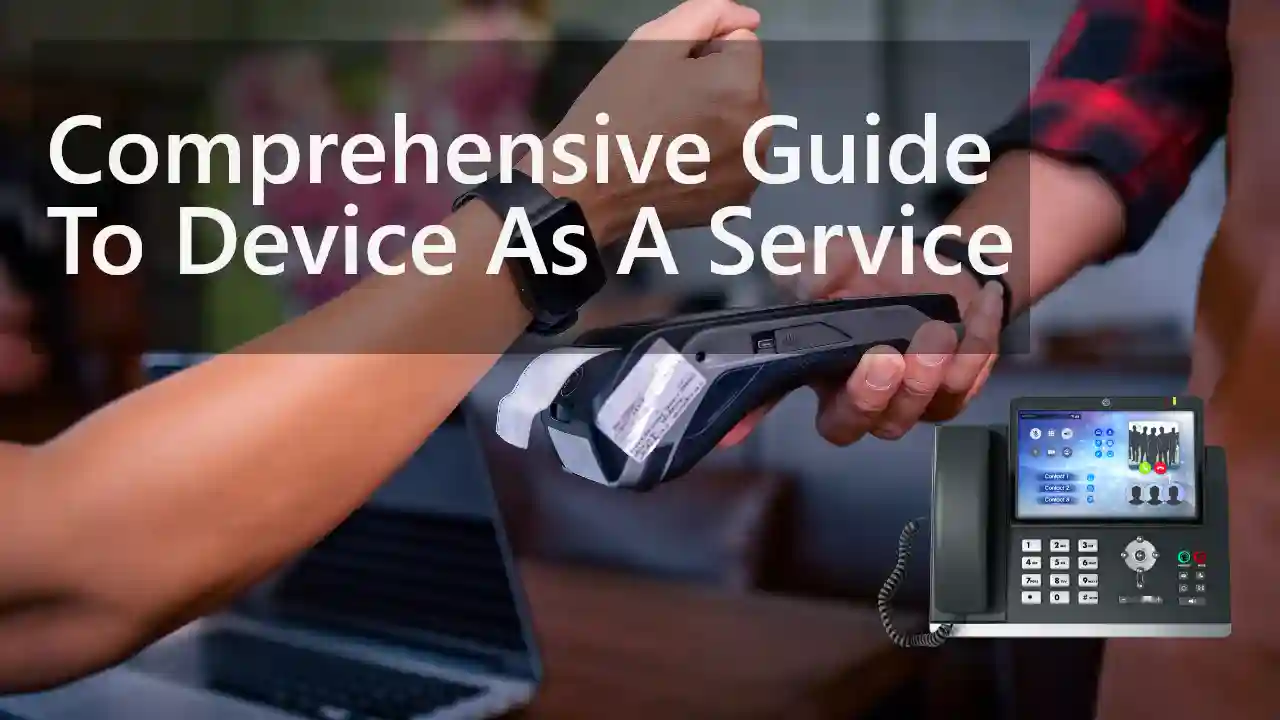You may have heard the term “Device as service” or “Daas” because it is getting popular with businesses across all industries. Everything is changing in this advanced tech age, including how products and services are used.
For instance, imagine if you can optimize the total cost of hardware, streamline vendors, minimize the IT team’s workloads, reduce tech clutter and provide a higher level of communication security to your remote teams only with a single, smart move.
It can be highly beneficial for the productivity and efficiency of business operations. Daas can help you do that and bring transformation that helps your business meet market demands.
If you do not know about this technology, do not worry. This article will describe all the essential things you need to know about Devices as a Service.
What is a Device as a Service?
The Device as a Service bundle offers IT equipment and management services. Simply put, it is a model that can provide your business with IT and hardware support simultaneously. It is a subscription-based or paid service that outsources the software, hardware and management to an external provider.
A Daas solution provider is responsible for providing, distributing and managing devices for your workforce in the office, home or field. For example, suppose you are looking for communication equipment and service.
In that case, a Daas deployment includes different headsets and hardware related to video calling at a fixed monthly subscription fee. Your Daas provider will also provide IT support to leverage these devices.
In recent years, the rise of Device-as-a-Service (DaaS) has led to the emergence of new players in the market, including OTT service providers. These providers offer various services, including device management, security, and support, making it easier for businesses to manage their devices and ensure they are always up-to-date and secure.
In addition, when you subscribe to a provider, you can update equipment at the end of the lease period without paying the cost typically associated with a device refresh.
Why Is DaaS Becoming Popular?
A device as a service is becoming increasingly popular with time because it makes businesses easier by providing several benefits. It is helping businesses in improving organizational infrastructure while saving money. That is why many companies are choosingOpEx (daily expenditures such as hardware subscription) over CapEx (making an upfront investment in owned hardware).
Research shows that the DaaS market is growing continuously, and there are no chances of slowing down. According to Grand view research, the global DaaS market size was 30.75 billion dollars in 2020, and it is expected to grow to 37.8% by 2028.
We all know that a hybrid work model always comes with challenges. Most businesses had to reimagine their workspaces while accommodating workers looking for more flexibility. However, it is not an easy task to redesign a workspace, and it requires much money.
Equipping your remote workforce with the devices they need to complete their tasks securely and efficiently is costly. The DaaS allows businesses to equip their remote employees with the necessary devices through a cost-effective subscription-based service.
By choosing the Device as a service model for your business, you can lower your capital cost while ensuring you have all the required equipment and the right infrastructure.
What Is The Difference Between Device as a Service And Leasing Equipment?
DaaS and leasing equipment are ways to access technology resources without purchasing them outright.
It may seem that DaaS is similar to leasing equipment, but there are some differences that you must keep in mind to choose the right option for your business:
I. Ownership
With leasing equipment, the lessee has temporary ownership of the equipment and is responsible for maintaining it, while with DaaS (Device as a Service), the provider owns and manages the hardware and software, and the customer pays for access to the service.
II. Scalability
DaaS offers more scalability than leasing equipment, as customers can easily add or remove users and adjust their usage based on their needs. In contrast, leasing equipment often involves fixed terms and limitations on the number of users or devices that can be added.
III. Upgrades
DaaS providers typically offer regular upgrades and maintenance as part of the service, while lessees may need to negotiate upgrades or pay additional fees.
IV. Cost Structure
The cost structure of DaaS is typically more predictable, with a fixed monthly fee per user, while leasing equipment often involves upfront costs and variable monthly payments based on the equipment leased.
DaaS and leasing equipment offer different benefits and drawbacks depending on the customer’s needs. DaaS is more flexible and easier to scale while leasing equipment offers more control over the equipment and may be more cost-effective in some cases.
Benefits of Device as a Service

DaaS is becoming a popular choice for forward-thinking businesses due to the following benefits:
1. Reduced Cost
DaaS allows businesses to deploy required hardware at any time at a lower monthly rate instead of purchasing costly hardware. You can easily scale your DaaS model as your business scales.
It means you will always have the hardware you need for your employees without investing much money. In other words, you can change the hardware cost from capital expenditure to an operating expense.
2. Improved Employee Experience
DaaS (Device as a Service) simplifies your tech stack and benefits your IT department and end-users. It provides the latest hardware and software, giving employees confidence that their data is secure.
Access to full tech support, regardless of location, allows your workforce to remain productive, efficient, and secure.
3. Device Life Cycle Management
With a device-as-a-service solution, device management is taken care of automatically, including updates and patches as needed. It allows you to focus on adding value to your business while your DaaS vendor handles the nitty-gritty details of device management. When a device reaches the end of its life cycle, your DaaS vendor can easily handle its retirement.
4. Consolidation Of Tech Stack
Choosing a DaaS provider that can provide both hardware and software will help you simplify your tech stack.
5. Tech Support
Have you ever purchased equipment only to find out that if something goes wrong, you can fix it on your own without anyone’s support?
Choosing a DaaS model for your business helps you in avoiding such scenarios. It includes maintenance and support. It means that when there is a problem, your Device as a service provider will be present to fix it.
If any of your devices are malfunctioning or broken, you can return them for repair or replacement. Yes, it is that simple.
6. Reduces IT Team's Burden
One of the most significant benefits of adopting the DaaS model is its effect on your IT team. According to a study, Device as a service helps reduce IT workloads by up to 16%, and small businesses benefit the most.
It is an advanced service model that helps businesses streamline their workflows by providing their team members with the right equipment for optimal performance.
Things To Consider When Choosing DaaS For Your Business

Once you decide that you want to enjoy the benefits that come with a device as a service model, there are some factors that you need to consider. These factors will help you choose which DaaS solution is best for your business.
1. Determine Your Business Needs
Planning is the key to success, so it is essential to identify your business needs. If you already have devices in your workplace, make a list of them and compare them to what you need to have.
Consider how your devices will be used and what integration you need to streamline your business operations and support your employees.
2. Business Size
When choosing a device as a service for your business, remember that your business size matters. How many devices you need for your business depends on your current business size, employee number, and desired workflows.
Always choose a lender who can fulfil your current needs and be able to scale when your business grows.
3. Choose The Top Level of Hardware
One major advantage that DaaS solutions provide your businesses is the ability to use state-of-the-art hardware without making a huge capital investment.
You do not need to use inferior hardware due to the low budget. Choose a DaaS provider that offers top-class hardware to enjoy a professional experience.
4. Consolidate When Possible
Another benefit that you can get from the DaaS model is decluttering your tech stack. But it is only possible when you choose your provider wisely. We suggest you choose a vendor offering software, hardware, and IT management all in one place.
5. Look For Support Options
Excellent support is an essential part of a robust DaaS solution. Look for a provider ready to offer support anytime, anywhere, to keep your business operations running smoothly. If you find support options lacking, move to another vendor to avoid any inconvenience later.
6. Security
Security is another major factor you must consider when choosing your DaaS vendor. Your vendor must have the best security to protect your business and workforce.
Once you examine all the points we mentioned above, it will become easier for you to find a DaaS provider according to your choice. You must research, shop around and interview a few vendors before deciding.
Conclusion - Device As a Service
In conclusion, DaaS is a subscription-based model offering businesses IT equipment and management services. It provides a range of devices and IT support to the office, home, or field employees. By outsourcing software, hardware, and management to an external provider, businesses can focus on adding value to their operations while the provider handles the management and lifecycle of the devices.
With DaaS, businesses can change the hardware cost from a capital expenditure to an operating expense, allowing them to easily scale their operations without investing large sums of money.
Additionally, access to the latest hardware and software and full tech support ensures a productive, efficient, and secure workforce, regardless of location.




